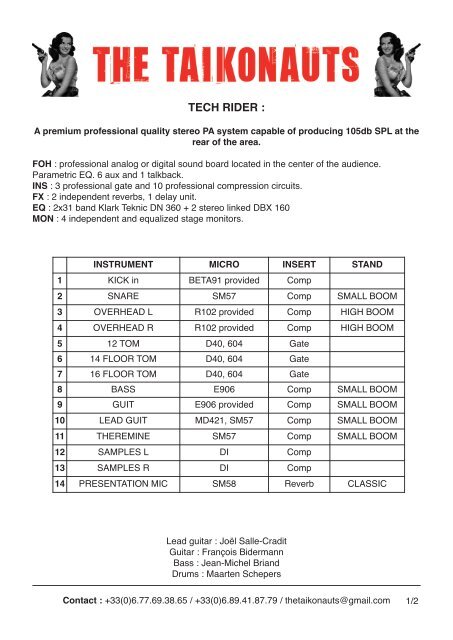
This article refers to the latter, the document provided by a band to a promoter, often refered to as a technical rider. This will typically include preferred audio equipment, an input list, monitor list and a stage plot. This will typically be sent out to the relevant contacts of all companies coming into a venue so that they know what to expect when they walk through the door.Ī band may provide a tech spec to a promoter or venue that outlines what equipment and conditions are required for them to do their show to the highest standard. It may also include venue diagrams and rigging information. It may also refer to documents relating to equipment, although this is out of the scope of this article.Ī venue may provide a tech spec detailing all of the equipment in use in the venue, as well as relevant issues such as power location / rating, stage dimensions, wing space etc. I have a good idea of what information is necessary in order to convey a band’s technical requirements with a minimum of fuss and maximum clarity.įor our purposes, a technical specification (or tech spec) is a document outlining all the necessary technical information of a facility or band. As a band engineer, I’ve also written plenty.

Stage plot pro samples series#
Since the input data are only a limited sample of the series, the sample autocorrelation functions computed from the input series only approximate the true autocorrelation function of the process that generates the series.As a sound technician, I have come across countless channel lists, stage plots and technical riders, some of them excellent and some of them good only for scrap paper. Most textbooks on time series analysis, such as Pankratz (1983), discuss the theoretical autocorrelation functions for different kinds of ARMA models. This matching of theoretical autocorrelation functions of different ARMA models to the sample autocorrelation functions computed from the response series is the heart of the identification stage of Box-Jenkins modeling. In the usual Box-Jenkins approach to ARIMA modeling, the sample autocorrelation function, inverse autocorrelation function, and partial autocorrelation function are compared with the theoretical correlation functions expected from different kinds of ARMA models. The partial and inverse autocorrelation function plots are also useful aids in identifying appropriate ARMA models for the series. The next step in the Box-Jenkins methodology is to examine the patterns in the autocorrelation plot to choose candidate ARMA models to the series. Note that the period of differencing is given as 1, and one observation was lost through the differencing operation. The summary statistics output from this IDENTIFY statement is shown in Figure 7.5. To difference the SALES series, use another IDENTIFY statement and specify that the first difference of SALES be analyzed, as shown in the following statements. That is, instead of modeling the SALES series itself, you model the change in SALES from one period to the next. The p -value for the test of the first six autocorrelations is printed as p -value is less than 0.0001. The autocorrelations are checked in groups of six, and the number of lags checked depends on the NLAG option. This is an approximate statistical test of the hypothesis that none of the autocorrelations of the series up to a given lag are significantly different from 0. In this case, a visual inspection of the autocorrelation function plot indicates that the SALES series is nonstationary, since the ACF decays very slowly.įor more formal stationarity tests, use the STATIONARITY option. See the section The Inverse Autocorrelation Function for a discussion of the inverse autocorrelation plots.
Stage plot pro samples how to#
Most books on time series analysis explain how to interpret the autocorrelation and the partial autocorrelation plots.
Stage plot pro samples serial#
Stage Plot Pro 2.9.9 Serial How To Interpret The The NLAG option controls the number of lags for which the autocorrelations are shown.īy default, the autocorrelation functions are plotted to lag 24.



This part of the IDENTIFY statement output is shown in Figure 7.2. Stage Plot Pro 2.9.9 Serial Series SALES Generated.Stage Plot Pro 2.9.9 Serial How To Interpret The.


 0 kommentar(er)
0 kommentar(er)
